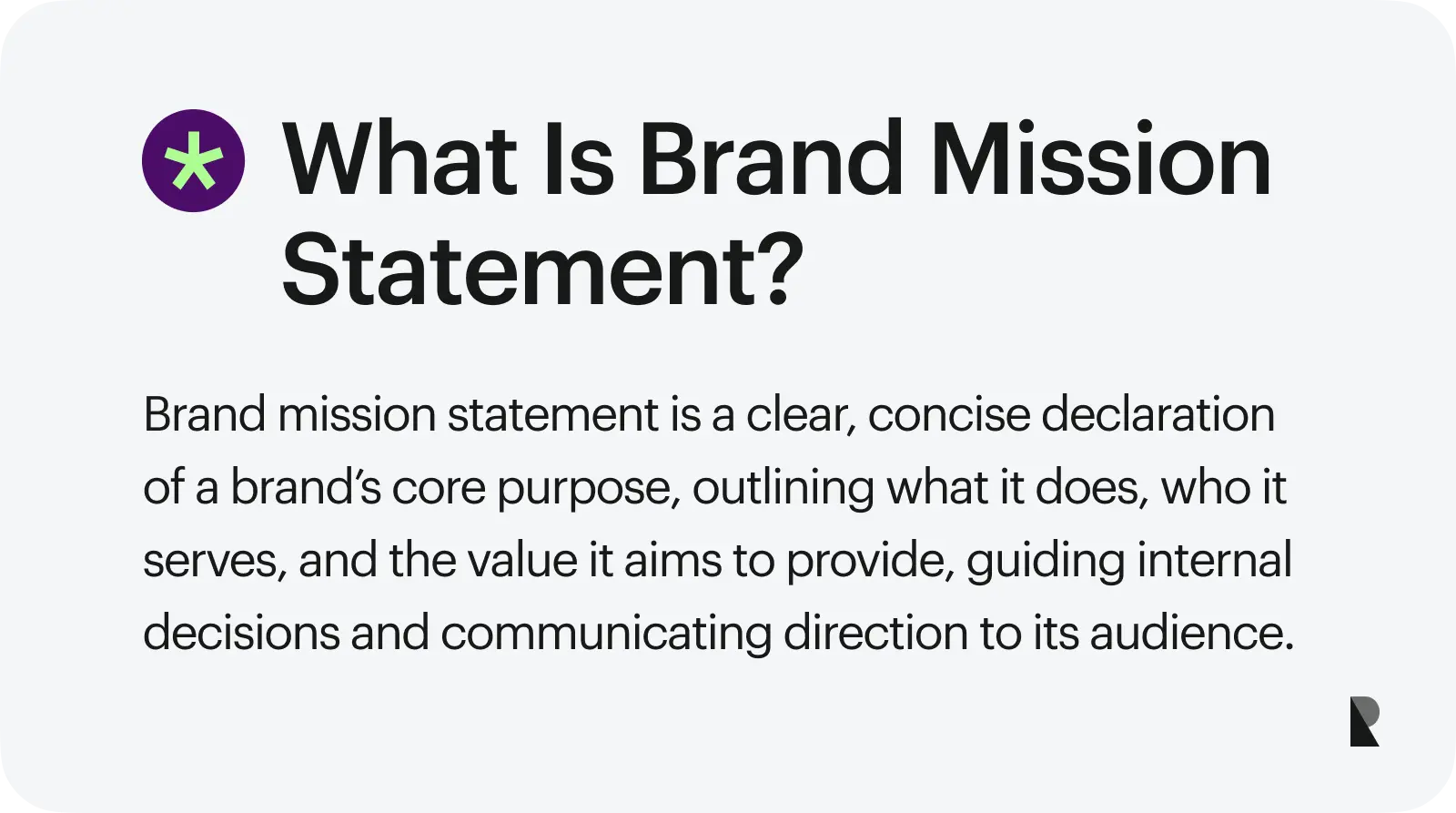
The brand mission is a concept that usually needs to be addressed and addressed by companies because it seems straightforward and easy to define. As they put it, all it takes to handle it is just coming up with one or two sentences that describe the company's ideology. However, an actual mission statement reflects much more than that.
As with any core brand identity element, it is much more meaningful than you can imagine. It plays a crucial role in brand development and is indispensable as a company grows and evolves. Not only does it empower all brand strategies, but it shapes the brand outside and inside.
Let's learn more about this term by diving into its meaning, importance, examples, and, most importantly, steps and tips for crafting a strong brand mission statement that plays along with other brand elements, assisting the company in achieving its goals.
Brand Mission: The Basics
When you define a brand mission, it is easy to misunderstand the concept because it seems self-explanatory. As noted, it is much deeper than you can imagine and expect. It encompasses not one but several crucial details about the company. Let's dive into it from the marketing and branding point of view to get to the bones of the term and understand why professional brand specialists prioritize it and call even top brands to commit to it to the full extent.
So, what is the brand mission, and what roles does it play in the company's short- and long-term success?
imply put, the brand mission defines your company: what it does, how it does that, and why. It encompasses and reveals vital brand elements that make the company unique. Like brand vision and values, it defines a brand's soul, personality, and charisma.
You can consider the brand mission as a tool to clarify your company's purpose, the unique offer, and the promise you make to your target audience and stakeholders.
From a marketing point of view, it is an action-oriented roadmap that carves a clear path for your business and empowers well-aligned and coordinated campaigns and strategies.
The role of the brand mission is critical for the company, even though many businesses, especially startups, neglect it. Underlying the core foundation of a company's existence, much like a brand vision or value proposition statement, it serves as a "North Star" that navigates the company through all its endeavors and decisions. It is a cornerstone of every process occurred in the company: from conversations with the clients to talent hunting to partnership agreements. Every person in every department across all verticals should be perfectly aware of the brand mission to channel efforts in the right direction and push the company towards its goals.
A brand mission can be descriptive and lengthy, but how can you deliver your message and create something meaningful and lasting? It is here where the brand mission statement comes in.
The relevance of a good mission statement in a business context is considerable. Not only does it define the company's essence and existence, as well as keeps it on track during everyday, landmark, and prompt decisions. It informs the market about the brand's purpose and reasons for existence and helps them understand what it aims to accomplish, how it will improve their lives, and what place it should occupy.
On top of that, it shares a unique perspective with the marketplace and creates an aura of exclusivity around your company. In an oversaturated market where every niche is packed with offers and new brands appear like hot pancakes, this precise definition of a brand's purpose is crucial for a company to stay afloat, separate itself from the crowd and win over a special place in customers' hearts.
If you are still trying to convince of a brand mission's relevance and importance, consider other good reasons why are clear mission statements important.
Importance of Brand Mission
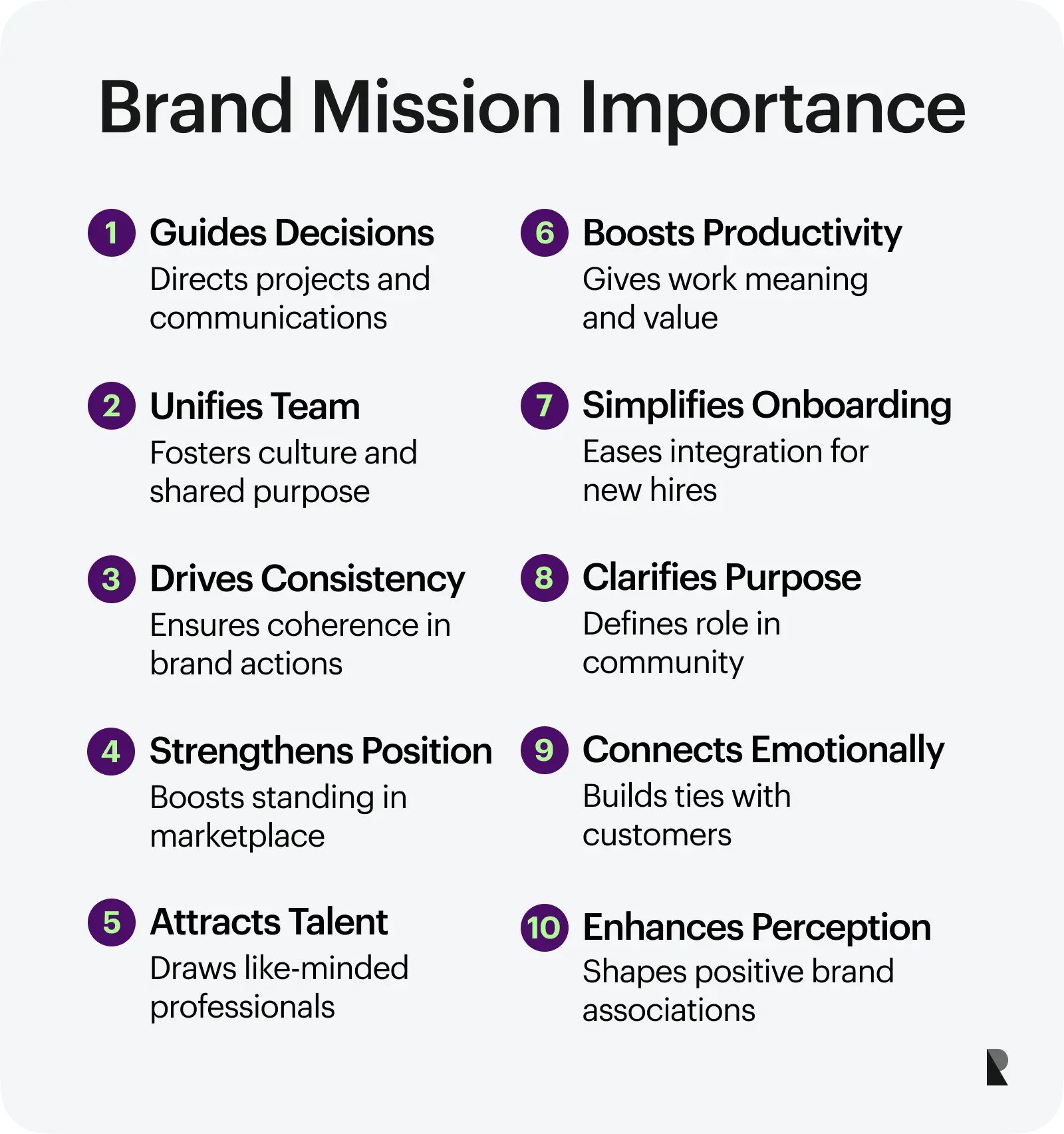
The brand mission is crucial for a company for many reasons. This is because, as a mission statement, it navigates all its projects, campaigns, and external and internal messages and communications, influencing the company's perception by target audience and departments. It impacts everything. Just consider what it can do when it is well-defined:
A company's mission statement acts as a powerful compass, guiding and empowering every core decision. It's not merely an array of words, but a profound affirmation of the brand's identity, shedding light on its existence to both internal departments and the external target audience.
This crystal clear expression of identity fosters unity across all verticals, fortifying the company's culture and cultivating an empowering workplace environment. It's the unseen force standing firmly behind every strategic brand initiative, cementing the company's position in the competitive marketplace.
The mission statement doesn't merely maintain status quo, but spurs consistency and coherence, fueling the brand's development and propelling its growth. It works symbiotically with other brand identity elements, enhancing them and in turn, securing the company's place in the oversaturated market. This unyielding proclamation ultimately serves as the company's flag, proudly planted under the relentless sun of competition.
There is more. Consider the importance of defining brand mission statements from other perspectives.
For instance, it is crucial for a company's inner potential. The clearly defined mission statement builds a strong pool of employees by attracting like-minded professionals who are on the same page. It improves the productivity and performance of employees by showing the meaning and reason of their jobs and cultivating a sense of belonging to something big and vital. On top of that, it makes onboarding easy and enjoyable since by reflecting the brand values. The mission statement encourages new employees to become valid players from the first days.
A mission statement is also vital for consumer perception for these reasons:
- Clarifing the business and its products to the target audience, eliminating confusion.
- Definng the company's place, role, and importance in the community.
- Breaking the ice to secure new leads.
- Building positive associations with the brand in the community.
- Making new products and services of the company more attractive to customers.
- Connecting with community members and even creates its community inside and outside the company.
- Establishing an emotional connection between the company and consumers, tugging customers' heartstrings to achieve their goals.
The mission statement is a brand identity that underlies everything, especially overall business success.
Brand Mission vs. Other Brand Elements
Let's consider brand mission in the context of brand identity to clear things out because terms like mission and vision statements can be confused, as well as how it interacts with other brand elements.
First, mission and vision statements are often used interchangeably. To get this right, a vision statement describes goals, ambitions, and plans. At the same time, the mission statement describes the purpose of the company's existence in the present. Together they put a united front to forward the company.
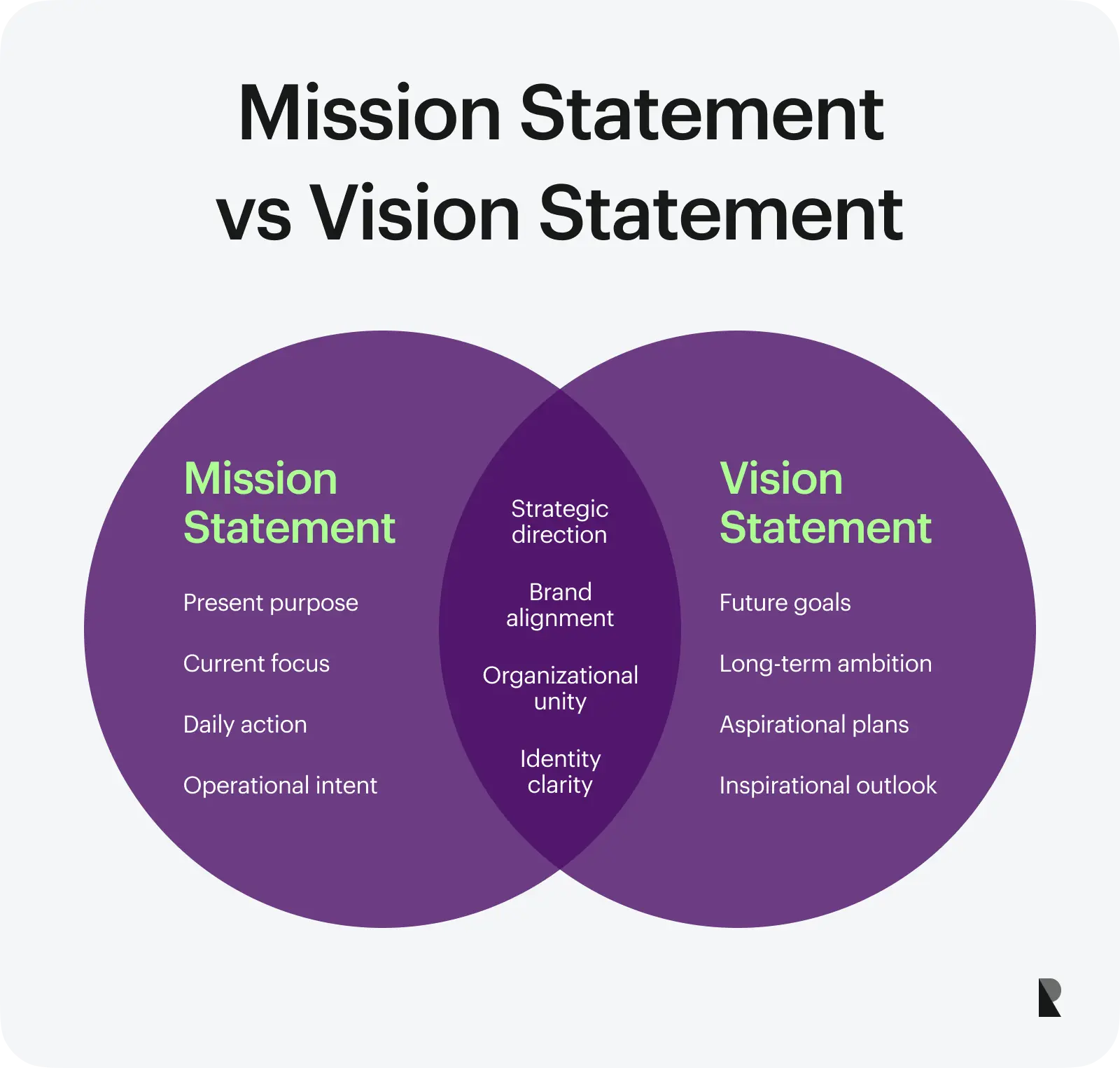
Second, brand mission vs. brand promise. This is another pair that needs clarification. To make it easy to understand, remember that brand promise is based on brand purpose and values. In comparison, brand mission makes brand values meaningful to the crowd and helps to fulfill the brand promise.
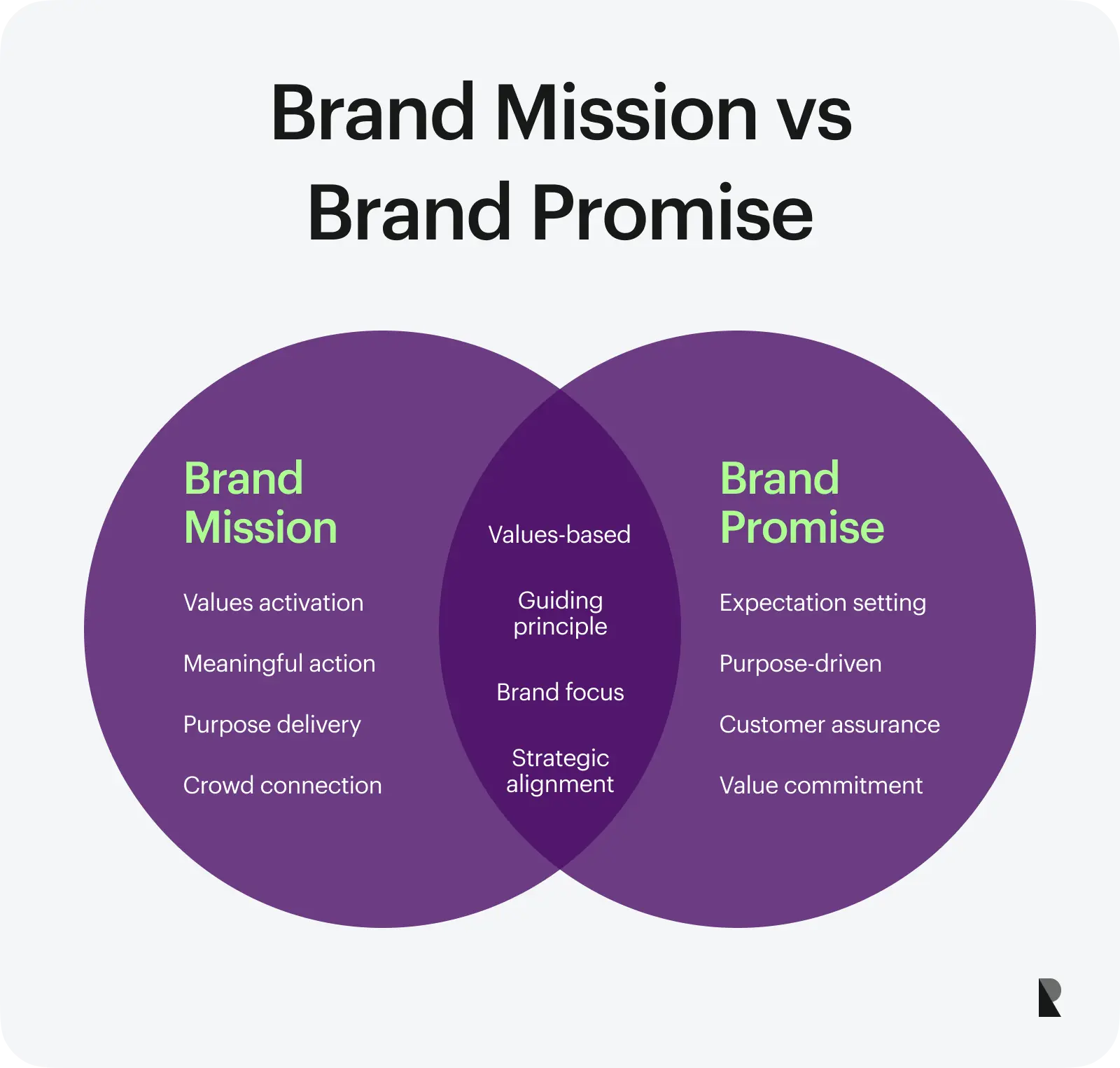
Third, brand mission and brand personality. As you may have guessed, these two terms are different, yet they are tightly linked. Brand personality is a more prominent term encompassing the brand's mission, core values, vision, and charisma.
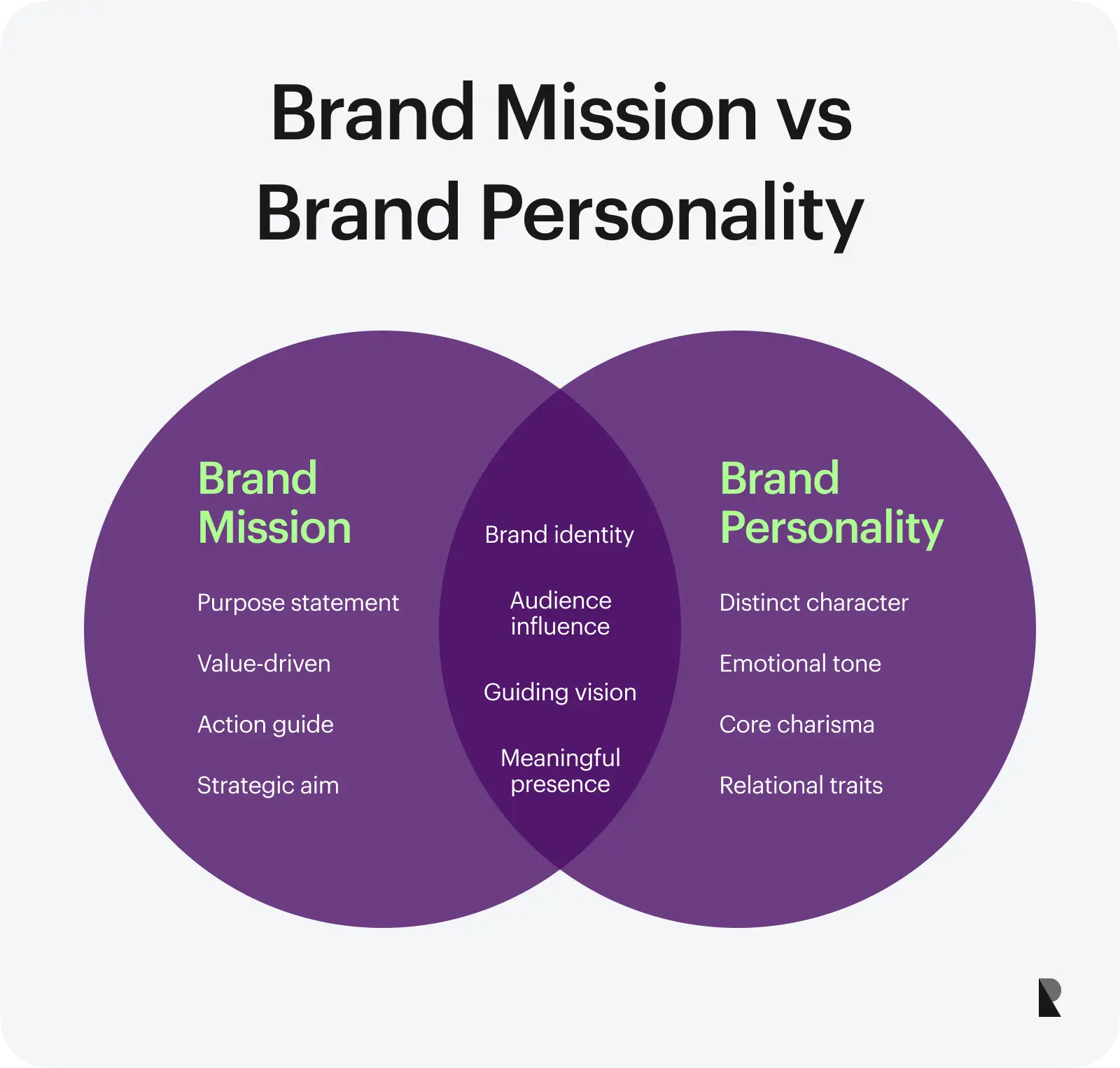
Fourth, brand mission and visual identity. These two are different but are closely related and even interconnected. The brand mission is reflected through visual identity, and at the same time, it hints at what logotype to create or what color scheme to choose during the design process.
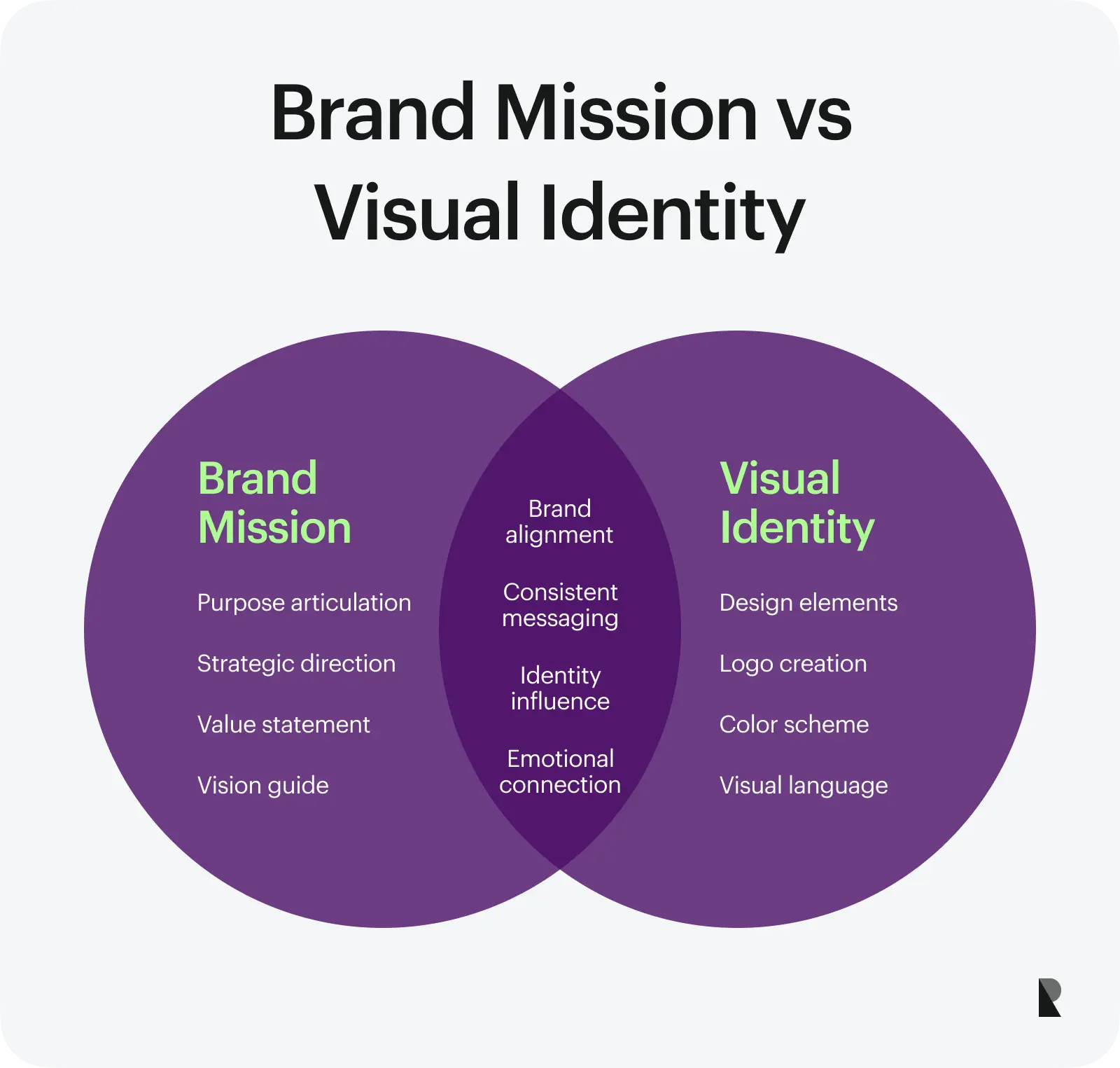
Finally, brand mission and brand voice. These separate terms interact with each other to create a coherent brand image and support other elements of brand identity. Brand voice is a specific style, tone, and collection.
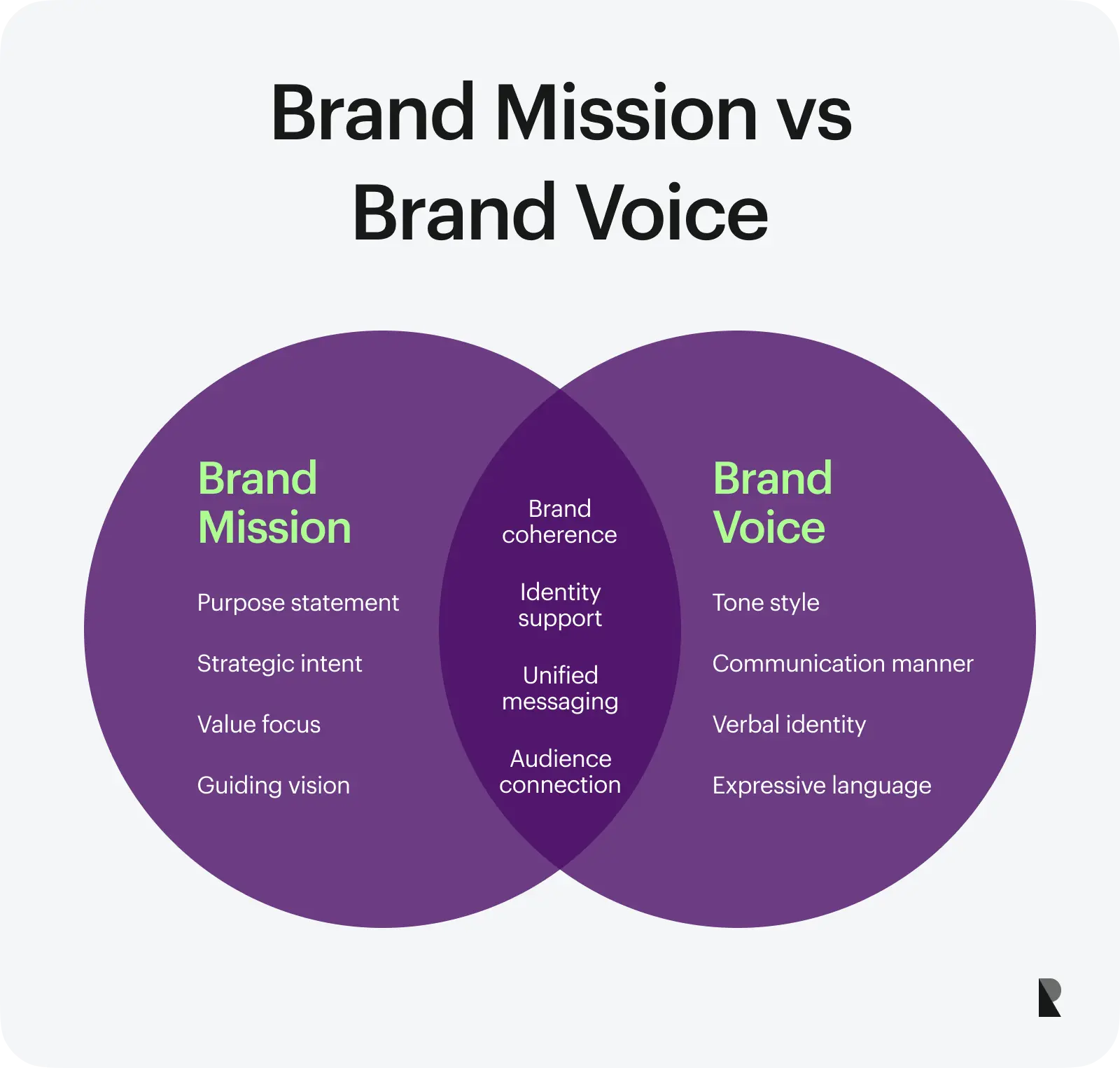
Step-by-Step Guide for Crafting Brand Mission
Crafting a great mission statement takes creativity and a thorough understanding of who you are, where you are heading, and why you should occupy a special place in the customer's heart. The mission statement should inspire the company's department since it underlies its culture and should unite everyone to channel efforts in the right direction.
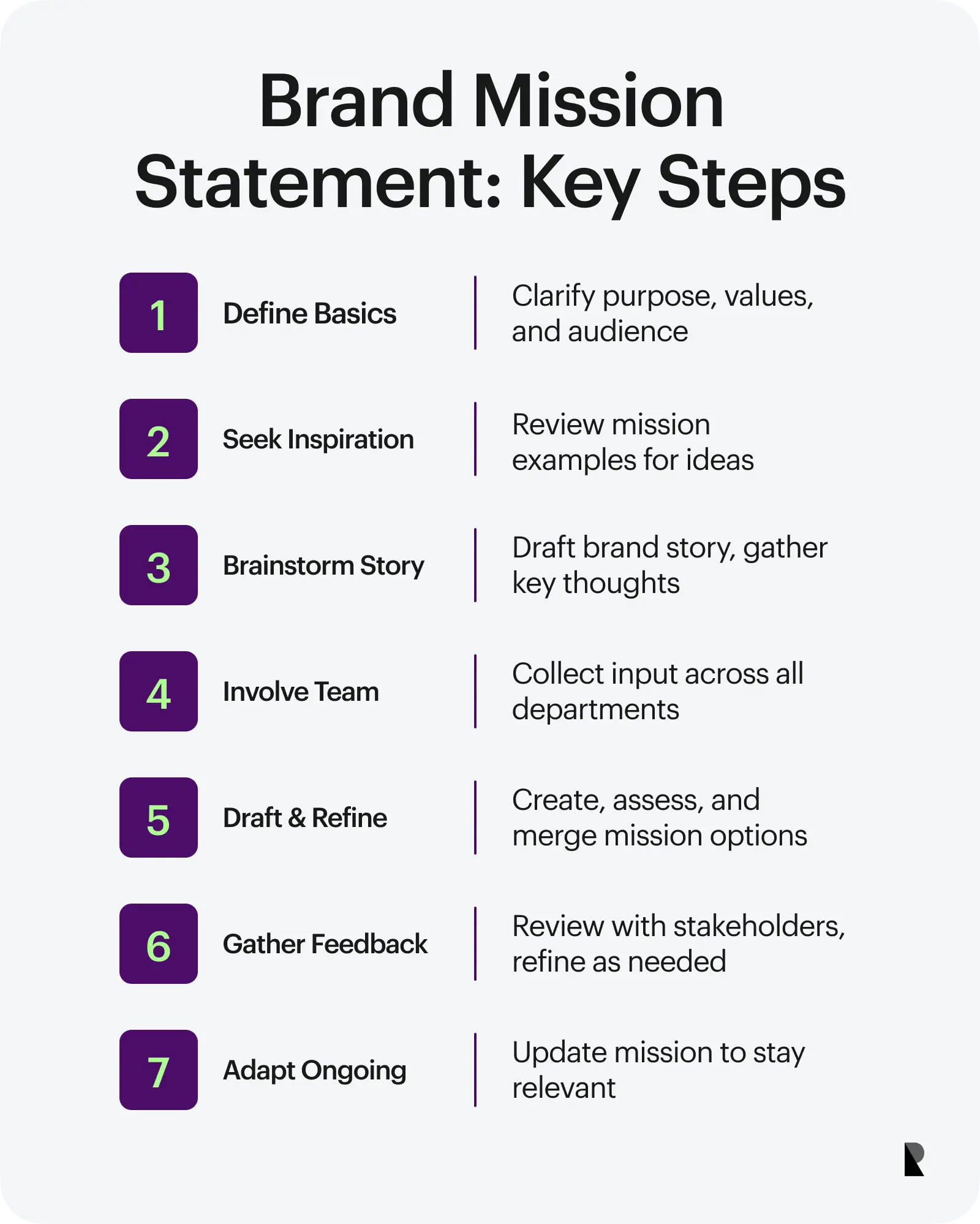
The task is not easy; however, it can be done with proper guidance. We have delineated seven basic steps that you need to undertake to craft a powerful, inspiring, and at the same time, all-embracing brand mission statement.
Step 1 – Nail the basics
As banal as it may sound, everything begins with the basics. The first thing to do is to understand clearly who you are and who your company serves. For this, determine the core values and ethics behind your company and its products or services. Reveal the ingrained principles of your company. Focus on your brand's personality, charisma, and the target audience's needs.
It would help to answer these questions:
- "Why does your company exist?"
- "What does make you different?"
- "How can you change your customer's life for the better?"
Step 2 – Get inspiration
Defining a brand mission statement calls for creativity and wit. It is here where you need inspiration. There are two places to find it.
First, inspect famous names. Even though they might not be in your niche and certainly not in your league, you can see how brand missions are done.
Second, consider other brands in your industry. Whether they are your rivals or businesses in related areas, they can give valuable cues on what might have worked with your target audience.
Step 3 – Gather your thoughts
Getting inspiration and determining who you are is a great base to move forward. The time has come for brainstorming. Many professional brand design agencies recommend gathering your thoughts by creating your brand story.
How to do this? Try free writing. Create an essay about your business. Every brand mission is closely related to the brand story, so why not write it down in your words and then shape it into something beautiful and concise? If you need to learn how to start, start by listing your company values, personality, charisma, principles, culture, vision, and goals. All these elements will help to shape the story correctly.
Mention how you can help customers to make their lives better. Point out what you can do for the community. Give reasons why you should stay in the market. Also, imagine your company's appearance in 5, 10, and even 25 years.
Put down your thoughts. They may need to be more organized at first. Do not be discouraged by that. Remember, it is a draft with a range of valuable ideas inside. Sometimes all we need is just one great idea.
Step 4 – Involve people from different departments
Even if you do not struggle with composing an essay about your company and its future, asking your teammates what they think is vital. If you
Step 5 – Identify several brand missions and check whether they meet your criteria
Here, it would be best to analyze your essay and thoughts gathered from teammates to develop several versions of the brand mission. Craft 2 to 5 different options. Check each one to meet your criteria. For instance, check whether it is specific, timeless, and inspirational. Whether it clearly defines who you are and addresses burning customer's issues.
After that, you can set your eyes on one that fits your requirements the best, or on the contrary, use ideas from different options to create a symbiosis from several versions.
Finally, summarize your brand mission by consolidating it into a couple of sentences since practice shows companies usually have an extended brand mission.
Try to fit everything into two sentences. Work with vocabulary to find powerful, actionable words. Also, remember to measure its readability and verify its difficulty level to ensure every person will get the meaning correctly.
Step 6 – Get feedback, and do not be afraid of critique
Feedback is essential. Whatever attitude you have towards analysis, this needs to be done. Focus on reviews from stakeholders, potential customers, and employees. Ensure your brand mission statement perfectly resonates with everyone. This helps avoid confusion and misunderstandings, save authenticity, and successfully deliver your core values to everyone.
Step 7 – Listen and adapt
Sometimes you need a new mission statement. The deal is that even your ingenious mission may lose its relevance and power. Market preferences and needs undergo constant changes. Therefore, listen to your crowd and adjust accordingly. Make changes to ensure the mission statement meets customers' demands and expectations and stays true to the company.
The Best Practices for Creating a Compelling Brand Mission Statement
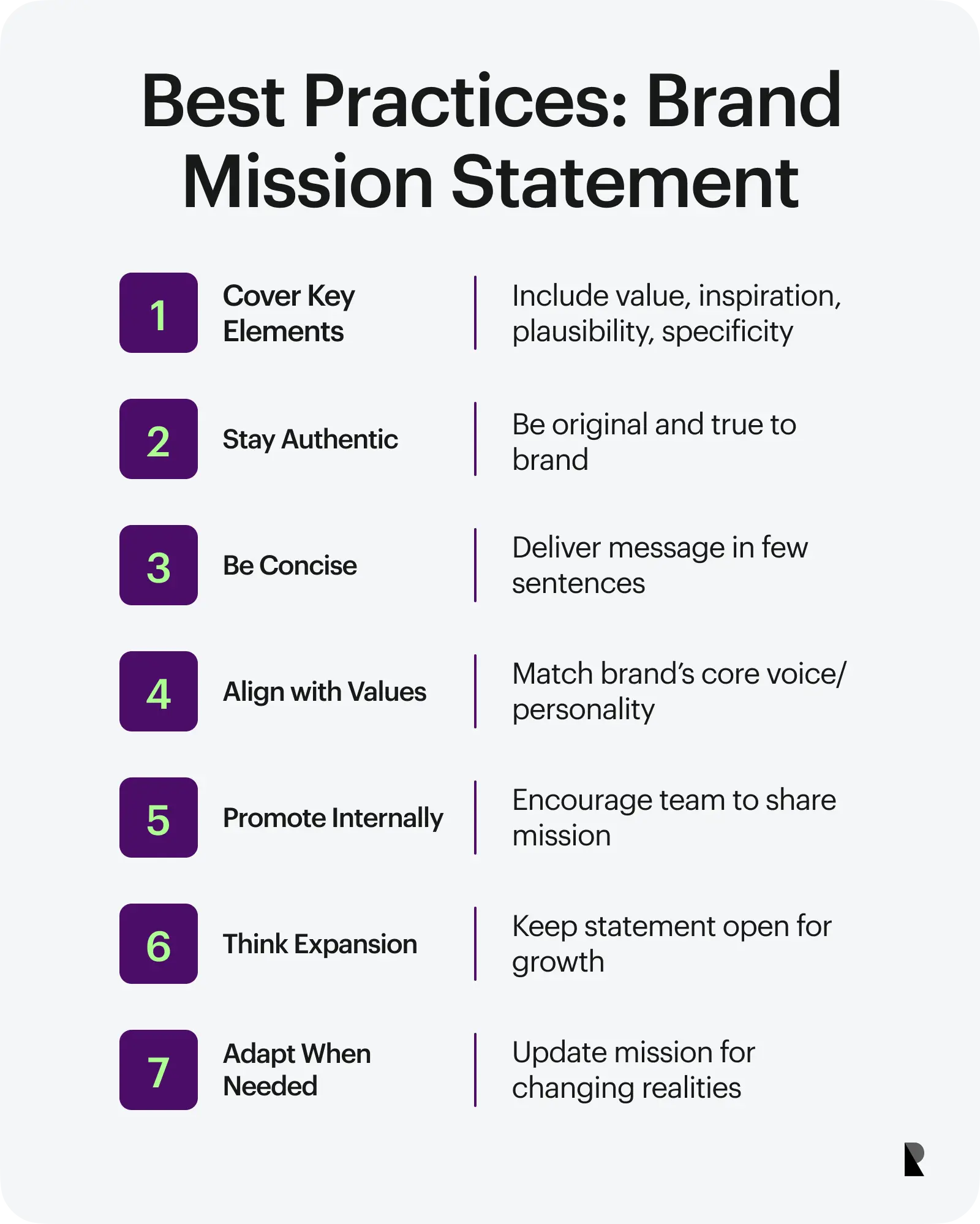
The guide provides a solid foundation to build a mission statement; however, sometimes, more is needed, especially if you have a radiant personality or fight for a spot in a competitive niche. In that case, it is highly recommended to follow the best practices. Here is a short list of what you can do to level up the game.
- Focus on four key elements of every powerful brand mission: value, inspiration, plausibility, and specificity.
- Get inspired by others but stay authentic, representative, and original. Ensure the brand mission statement is aspiring and inspiring for your team and target audience.
- Be concise and get straight to the point. No one will lose their precious time reading long declarations. Sum up everything you want to deliver in several sentences. Remember to use appropriate action words.
- Make it consistent with your brand's core values, personality, and voice.
- Encourage your team to promote your brand mission statement across distribution channels.
- Make it open. Even if you start as a local company, always hope to expand and grow your business.
- Do not be afraid of changes. Be ready to adjust your brand statement to new realities.
Brand Mission Examples
From theory to practice, let's consider several outstanding brand mission statements.
It may be one of the shortest and simplest brand mission statements. Though, brevity is the soul of wit. TED conference is one of the most anticipated events because it is where professionals share their thoughts and opinions, inspiring others. This concise statement encompasses precisely that. Simple yet powerful.
This is an excellent example of a lengthy statement. It encompasses all crucial details about the company and its values and goals. Every Disney animated movie is entertaining, inspiring, and enlightening. This brand mission statement worked 50 years ago with Walt Disney in charge, and it certainly works now because it is well thought out.
Organize the world's information and make it universally accessible and useful.
I bet you have guessed that right. This Google mission statement quickly builds associations with the company - proof of how a well-defined mission statement works. Unlike other brands, Google avoids fancy or witty mission statements. It is just brutally honest and gets down to business right away. Neat.
Conclusion
A brand mission statement is one of the most defined ways to establish a company. It is neat, precise, accurate, and at some point, simplistic and ingenious. It always needs clarification with the visual statement; however, it is a single, strategic brand identity unit.
It is a cornerstone that forms a solid foundation for everything. It guides all departments in their decisions, starting with conversations conducted by the customer support team and ending with website developers and product packaging designers. It is a "North Star" that encompasses the essence of your company (values, personality, vision statement, goals) and, at the same time, reflects your ways to meet the target audience's needs and expectations. In a word, it needs to be a multifunctional statement that connects all the dots.
Follow our guide to create a good foundation for your brand mission statement and then improve it with best practices and tips shared by professionals. Please give it a test, and always listen to your customers and teammates. Make changes if necessary, and always remember to promote it through all distribution channels to unlock its potential inside and outside the company.
Jun 9, 2023




 Google
Google
